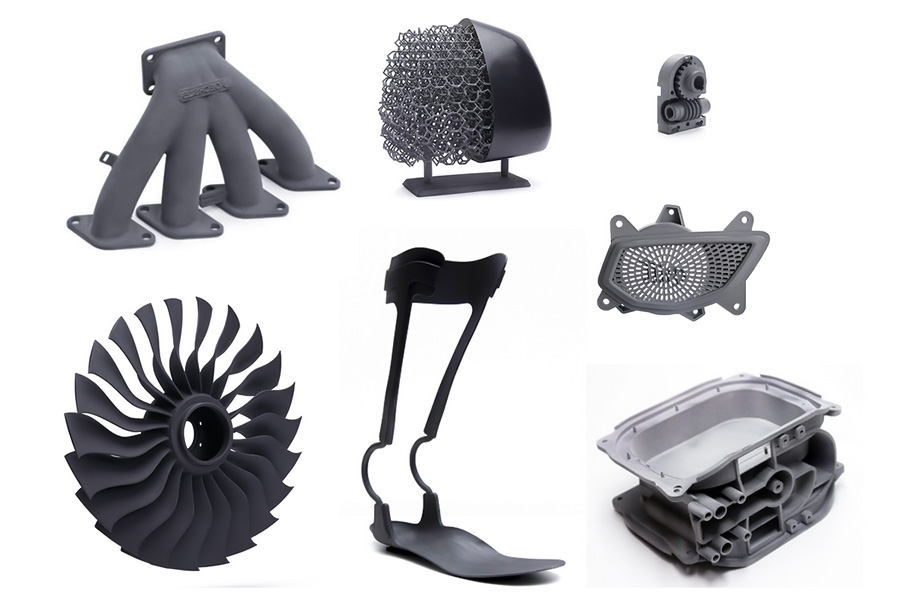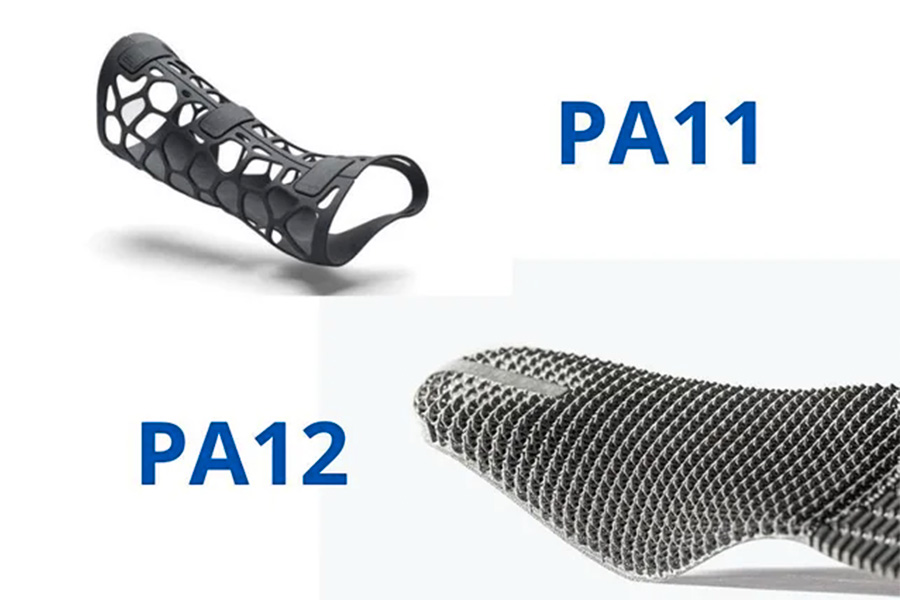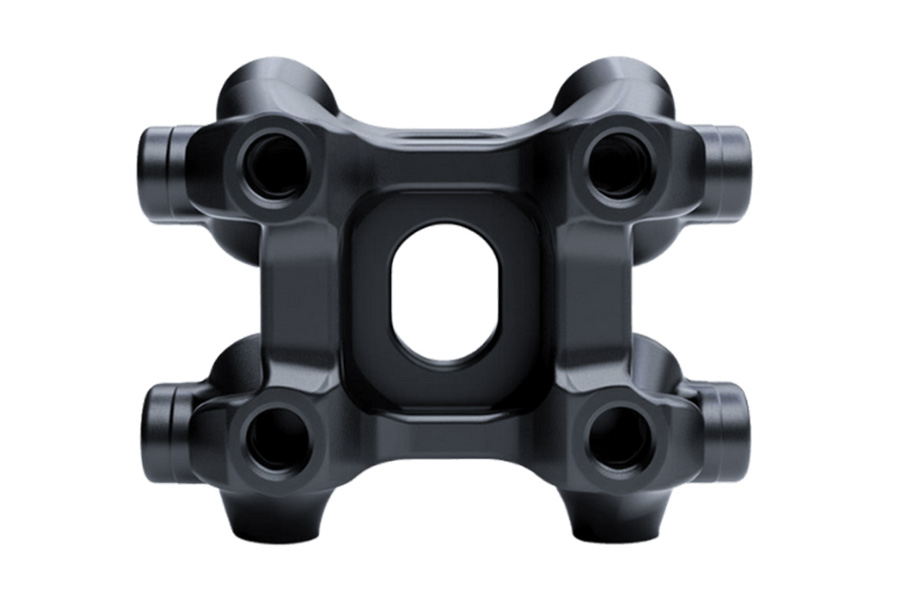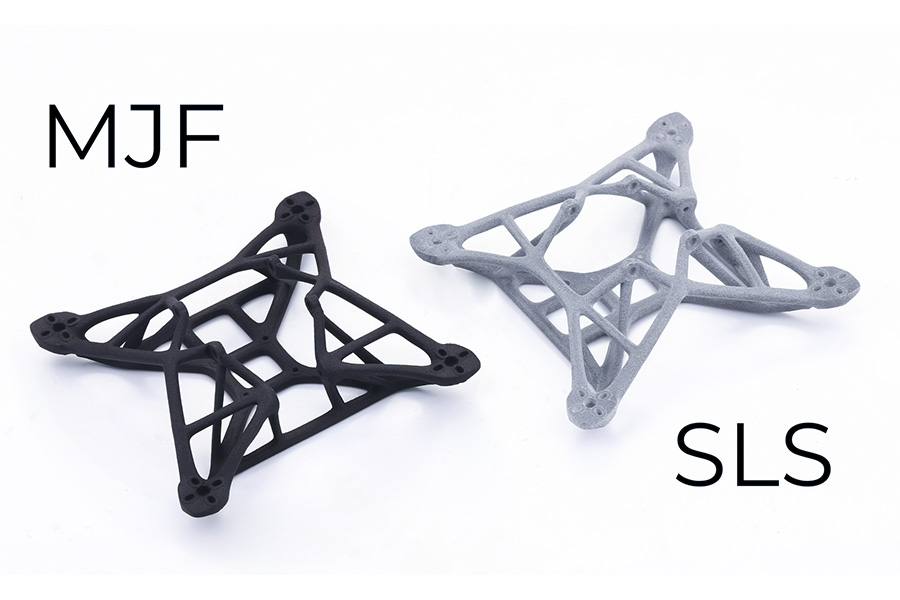As an innovative3D printing technology, multi-jet fusion (MJF for short) has demonstrated its unique advantages and wide application potential in multiple industries. The core of this technology lies in its use of powder bed technology and high-temperature jet melting technology to achieve a strong bond between layers to create high-precision, high-quality 3D models. So,what materials are used in MJF technology?LS will take everyone into the ocean of knowledge about multi-jet fusion and study the types of materials used in multi-jet fusion.
What Materials Are Used in multi jet fusion?
Multi-jet fusion (MJF) technologyhas been widely used in the field of3D printingdue to its high efficiency and high precision. This technology primarily uses thermoplastic powder materials, and here are some common material types:
| Materials | Features | Application |
|
Nylon 12 (PA12) |
PA12 is a high-performance nylon material with high strength, good abrasion resistance, chemical resistance and low moisture absorption. It maintains stable performance over a wide temperature range. |
Suitable for manufacturing various functional parts, such as automobile parts, tool handles, casings of electronic equipment, etc., especially where high strength and wear resistance are required. |
| Nylon 11 (PA11) | PA11 is more flexible than PA12, has higher impact strength and better low temperature toughness. It also has good chemical and abrasion resistance. | Suitable for manufacturing parts that require high flexibility and impact resistance, such as pipes, hoses, seals, etc. |
| Polypropylene (PP) |
PP is a lightweight material with good chemical resistance, heat resistance and low cost. It is easy to process and has good resistance to stress cracking. |
Suitable for manufacturing various lightweight components, such as containers, packaging materials, automotive parts, etc., especially where cost reduction and weight reduction are required. |
| TPU (thermoplastic polyurethane) |
TPU has rubber-like flexibility, high elasticity and wear resistance. It remains elastic over a wide temperature range and has good tear strength. |
Suitable for manufacturing parts that require elasticity, softness and wear resistance, such as soles, seals, hoses, sports equipment, etc. |
What Are the Material Properties in MJF Printing?
Thematerial properties of MJF (multi-nozzle fusion) printingmainly include the following points:
High strength to weight ratio:
The materials such asnylon (such as PA12) and polypropylene (PP) used in MJF printing technologyhave high strength and light weight, which makes the printed parts both strong and light, making it very suitable for application scenarios that have dual requirements for strength and weight.
Good heat resistance:
MJF printed parts usually have good heat resistance and can maintain stable performance in a certain high temperature environment. For example,PA12 nylon material can withstand local high temperaturesup to a certain temperature without deformation or loss of performance, which gives MJF printed parts a significant advantage in applications that require high temperature resistance.
Smooth surface and low porosity:
MJF technology is able to print parts with smooth surfacesand low porosity by precisely controlling the melting and solidification processes during printing. This high-quality surface helps reduce post-processing steps, improves production efficiency, and makes printed parts more beautiful and durable.
Functional components have excellent mechanical properties:
Functional parts printed by MJF usually have excellent mechanical properties, such as toughness, wear resistance, impact resistance, etc. These properties give MJF printing technology significant advantages in manufacturing complex and precise mechanical parts, which can meet various demanding working conditions and performance requirements.

How Do MJF Materials Compare to Other 3D Printing Technologies?
MJF (Multi-Jet Fusion) technology does show some unique advantages compared with other 3D printing technologies. The following is a comparative analysis of MJF andSLS (selective laser sintering), SLA (stereolithography) andFDM (fused deposition modeling) technologies:
| Type of technology | Type of material | Precision | Velocity | Cost | Material utilization | Printable material diversity | Strength and toughness |
|---|---|---|---|---|---|---|---|
| MJF (Multi-Jet Melting) | Nylon powder (e.g. PA12) | HIGH (1200 DPI) | Medium to fast | medium | High (80-85% recyclable) | limited | High, isotropic |
| SLS (Selective Laser Sintering) | Thermoplastic polymer powders | medium | medium | medium | Medium (50% recyclable) | Higher | Varies depending on the print orientation |
| FDM (Fused Deposition Modeling) | Thermoplastic filament | medium | Medium to slow | low | High (almost 100% recyclable, but with a support structure) | high | medium |
| SLA/DLP (Light Curing) | Photosensitive resin | high | Medium to fast | Medium to high | Low (need to deal with support structures, material waste) | medium | Medium to high |
| Binder Jetting | Metals, ceramics and other powders | Medium to high | Medium to fast | Medium to high | High (powder recyclable) | high | Varies depending on the material |
| Material Jetting | Photosensitive resins, metals, etc | high | medium | Medium to high | Low (need to deal with support structures, material waste) | Medium to high | Varies depending on the material |
What Are the Benefits of Using Nylon in MJF Printing?
The mainadvantages of using nylon in MJF’s printing processare:
- Nylon materialcombines high strength and excellent flexibility,While maintaining high strength, nylon also exhibits excellent flexibility, which ensures that the printed parts are both stable and elastic.
- Nylon parts exhibit excellent wear and chemical resistance, It is highly resistant to various chemicals and has excellent wear resistance to maintain stable performance in harsh working environments.
- Due to the relative lightweight and durability of nylon material, it not only helps reduce the weight of the overall device, but also ensures that components are not easily damaged during long-term use.
- In MJF printing technology, the characteristics of nylon are fully utilized. By precisely controlling the injection and solidification process of molten material, parts with high precision and excellent surface quality can be printed, thereby achieving excellent processing performance and accuracy.

What Are the Limitations of MJF Materials?
The mainlimitations of MJF (multi-nozzle fusion) materialsinclude the following aspects:
- Limited material selection:Although MJF technology has the ability to support a variety of materials, compared with other 3D printing technologies, the materials it can choose are still relatively limited. This factor limits the adaptability of MJF in specific application scenarios.
- The cost of the equipment is relatively high:The initial installationcost of MJF printersis often high, which may cause some trouble for users with limited budgets or small-scale businesses. The widespread application and popularization of MJF technology may be limited by high cost.
- Regarding the need for post-processing:Although MJF printed components usually have good surface quality, in some specific occasions, post-processing may still be required, such as removing powder residue or annealing. These subsequent processing steps may lead to an increase in production costs and time.
- Printing speed is limited:Although MJF technology has made improvements in printing speed compared to other 3D printing technologies, its printing speed may still be limited when dealing with large or complex parts. This may have an impact on production efficiency and delivery time.
- Regarding part size and shape limitations:When using MJF technology to print large or complex geometrically shaped parts, you may encounter some difficulties. Due to limitations in the size and shape of components, the applicability of MJF in certain specific application scenarios may be restricted.
- Material reusability:Although someMJF materials are highly reusable, this is not the case for all materials. The reusability of materials can be affected by a variety of factors, such as wear and tear during the printing process, contamination, etc. This can lead to increased material costs and wasted resources.

What Are the Industrial Applications of MJF Materials?
MJF (Multi Jet Fusion) materials have a wide range of industrial applications, mainly reflected in the following aspects:
- Automobile manufacturing:MJF technology is widely used to produce automotive parts, prototypes and tools, such as interior and exterior components, improving production efficiency and reducing costs.
- Aerospace:MJF technology produces lightweight and durable componentswith high strength-to-weight ratio and design flexibility to meet extreme environmental requirements.
- Medical equipment and prostheses:MJF technology is used to customize medical equipmentand prostheses to improve surgical success rates and rehabilitation effects.
- Industrial manufacturing and tool production:MJF technology produces functional components and tools, simplifying the production process and improving efficiency.
- Footwear manufacturing:MJF technology prints customized insoles and midsoles to provide comfort and support and reduce inventory costs.

Why ChooseLSfor Online 3D Printing Services?
- Multi Material Machining:We have the ability to handle multiple materials, and we can provide professional solutions no matter what material of parts you need to process.
- Competitive Pricing:We provide competitive prices and cost-effective solutions to ensure that customers gain the greatest advantage in cost control.
- Customized Services:Provide customized solutionsbased on customer design requirements and specifications to ensure that parts meet their unique needs.
- Rapid Delivery:We have efficient production processes and flexible production plans, which enable us to timely deliver customer orders and meet urgent project needs.
Summary
Multi-jet fusion technology has shown great potential and value in the field of 3D printingdue to its high efficiency, precision and flexibility. With the continuous advancement of technology and the continuous expansion of applications, MJF technology is expected to play a more important role in the manufacturing industry. In the future, we can expect to see more innovative applications and technological breakthroughs based on MJF technology, injecting new vitality into the development of the manufacturing industry.
Disclaimer
The content on this page is for reference only.LSdoes not make any express or implied representation or warranty as to the accuracy, completeness or validity of the information. No performance parameters, geometric tolerances, specific design features, material quality and type or workmanship should be inferred as to what a third party supplier or manufacturer will deliver through the Longsheng Network. It is the responsibility of the buyerseeking a quote for partsto determine the specific requirements for those parts.Pleasecontact usfor moreinformation.
LS Team
LS is an industry-leading companyspecializing in custom manufacturing solutions. With over 20 years of experience serving more than 5,000 clients, we focus on high-precisionCNC machining,sheet metal fabrication,3D printing,injection molding,metal stamping,and other one-stop manufacturing services.
Our factory is equipped with more than 100 advanced 5-axis machining centers and is ISO 9001:2015 certified. We provide fast, efficient, and high-quality manufacturing solutions to customers in over 150 countries worldwide. Whether it’s low-volume production or large-scale customization, we can meet your needs with delivery as fast as 24 hours. ChoosingLS Technologymeans choosing efficiency, quality, and professionalism.
To learn more, please visit our website:www.lsrpf.com
FAQs
1.What materials are used for fusion?
In 3D printing technology, especially those involving fusion processes (such as MJF, or multi-nozzle fusion technology), the main materials used in fusion include nylon (such as nylon 12 and nylon 11) and other thermoplastics. These materials become soft and fuse easily when heated, allowing them to form strong 3D printed parts.
2.Which of the following materials is used in material jetting?
In the material injection process, powdered thermoplastic materials are usually used. For MJF technology, it uses fine nylon powder. These powder particles are selectively sprayed and heated to fuse during the printing process to build the desired 3D shape.
3.How does multi-jet fusion (MJF) work?
MJF technology works through the following steps: First, a thin layer of nylon powder is spread over the print bed. Next, an inkjet head sprays a special binder in a predetermined pattern to bind the powder particles together. An infrared heating system then scans the entire layer, causing the bonded powder particles to melt and solidify to form a strong, solid layer. This process is repeated layer by layer until the entire 3D part is completely printed.
4.What materials are used in fused deposition?
Fused deposition modeling (FDM) is a widely used 3D printing technology that uses thermoplastic materials in filamentary form. These filaments are extruded after heating and deposited layer by layer on a printing platform to build the desired 3D shape. Common FDM materials include ABS, PLA, nylon, etc. Unlike MJF, FDM uses solid wire rather than powder material.
Resource







